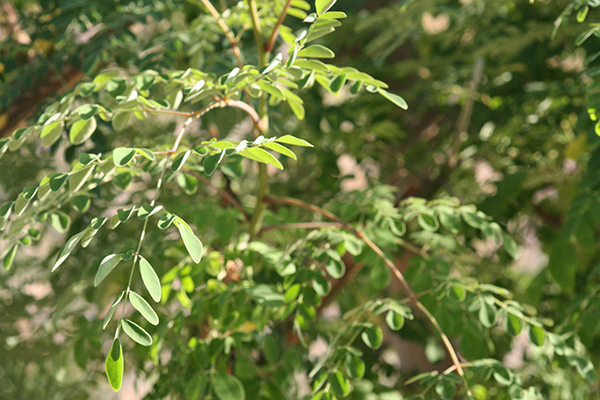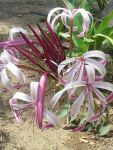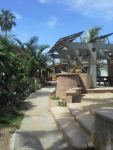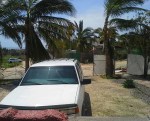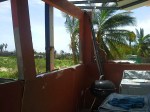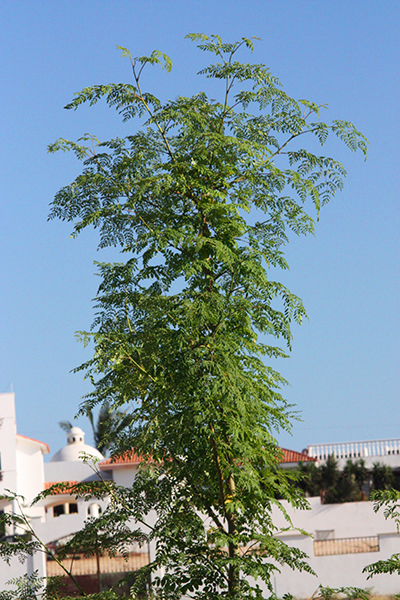 Moringa Tree…. We have been encouraged by the owner of the casa we rent to partake of the Moringa tree growing in our yard. He said it cured his Mother’s Diabetes, it is a miracle tree. Dan and I cut a branch and dried it over a couple of days and then added some to our tea to give it a try. We were not fond of the flavor (not dried long enough for sure) and kinda left it at that. Then along came Hurricane Odile, Sept 14th 2014, a category 4 hurricane when it struck the tip of the Baja peninsula, starting at Cabo and churning it’s way north. Todos Santos being about 40 minutes drive north of Cabo, we woke to an apocalyptic scene the morning of the 15th (I say “woke” like anyone in Todos Santos was sleeping that night).The Moringa Tree, on the side of the property facing the storm head on, had lost every single one of it’s leaves and most branches. It was a sorry looking trunk where a big beautiful flourishing tree had been the day before.
Moringa Tree…. We have been encouraged by the owner of the casa we rent to partake of the Moringa tree growing in our yard. He said it cured his Mother’s Diabetes, it is a miracle tree. Dan and I cut a branch and dried it over a couple of days and then added some to our tea to give it a try. We were not fond of the flavor (not dried long enough for sure) and kinda left it at that. Then along came Hurricane Odile, Sept 14th 2014, a category 4 hurricane when it struck the tip of the Baja peninsula, starting at Cabo and churning it’s way north. Todos Santos being about 40 minutes drive north of Cabo, we woke to an apocalyptic scene the morning of the 15th (I say “woke” like anyone in Todos Santos was sleeping that night).The Moringa Tree, on the side of the property facing the storm head on, had lost every single one of it’s leaves and most branches. It was a sorry looking trunk where a big beautiful flourishing tree had been the day before.
Now a month and a scattering of days after the storm I have to share this photo (above) of our “Tree of Life” or “Miracle Tree” or aka “The Drumstick tree” (almost every part of this tree is edible come to find out!). Taller, bigger, full of leaves, bursting with life. Enough of a miracle, yes, for me to lean on the google, and do some reading up on it. Wow. I nibbled a few leaves earlier today, fresh and sweet and very palatable, and feel quite cheered up, it is a natural upper, along with so many other things. Here are some of the benefits of this tree, and some links that I found interesting. In case you find you have a Moringa tree growing in your back yard, or happen across one – they grow in dry desert and sub tropical climates.
http://www.webmd.com/vitamins-supplements/ingredientmono-1242-moringa.aspx?activeingredientid=1242&activeingredientname=moringa
http://miracletrees.org/moringa_medicine.html
https://www.treesforlife.org/our-work/our-initiatives/moringa
From Web MD >
“Moringa is a plant that is native to the sub-Himalayan areas of India, Pakistan, Bangladesh, and Afghanistan. It is also grown in the tropics. The leaves, bark, flowers, fruit, seeds, and root are used to make medicine.
Moringa is used for “tired blood” (anemia); arthritis and other joint pain (rheumatism); asthma; cancer; constipation; diabetes; diarrhea; epilepsy; stomach pain; stomach and intestinal ulcers; intestinal spasms; headache; heart problems; high blood pressure; kidney stones; fluid retention; thyroid disorders; and bacterial, fungal, viral, and parasitic infections.
Moringa is also used to reduce swelling, increase sex drive (as an aphrodisiac), prevent pregnancy, boost the immune system, and increase breast milk production. Some people use it as a nutritional supplement or tonic.
Moringa is sometimes applied directly to the skin as a germ-killer or drying agent (astringent). It is also used topically for treating pockets of infection (abscesses), athlete’s foot, dandruff, gum disease (gingivitis), snakebites, warts, and wounds.
Oil from moringa seeds is used in foods, perfume, and hair care products, and as a machine lubricant.
Moringa is an important food source in some parts of the world. Because it can be grown cheaply and easily, and the leaves retain lots of vitamins and minerals when dried, moringa is used in India and Africa in feeding programs to fight malnutrition. The immature green pods (drumsticks) are prepared similarly to green beans, while the seeds are removed from more mature pods and cooked like peas or roasted like nuts. The leaves are cooked and used like spinach, and they are also dried and powdered for use as a condiment.
The seed cake remaining after oil extraction is used as a fertilizer and also to purify well water and to remove salt from seawater.
How does it work?
Moringa contains proteins, vitamins, and minerals. As an antioxidant, it seems to help protect cells from damage.”
